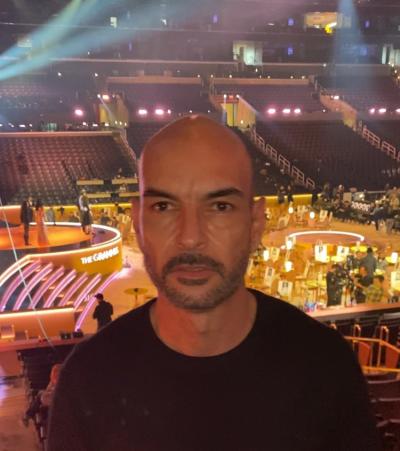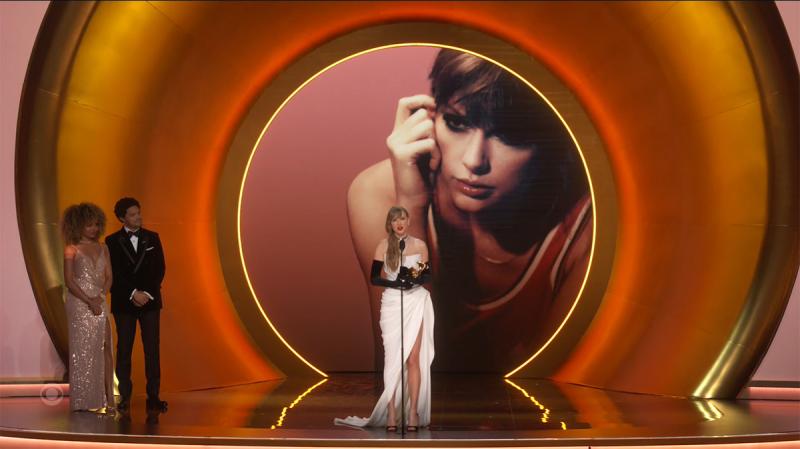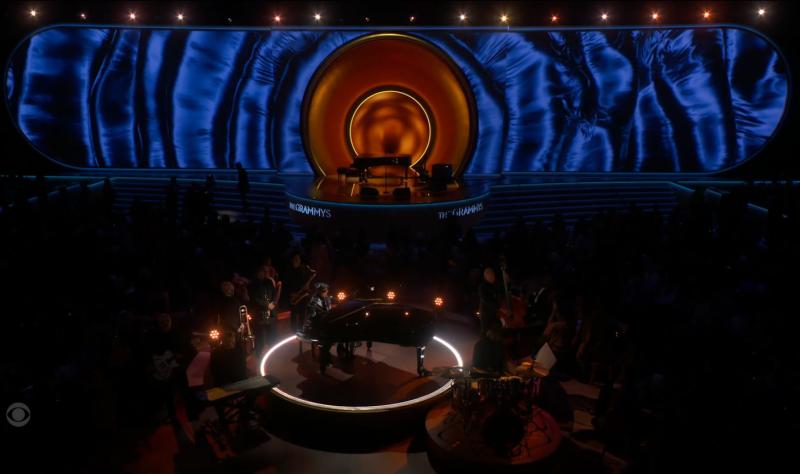New York-based Yellow Studio has created the production environments for some of the biggest live for broadcast events, and especially music events, including the Eurovision Song Contest, multiple GRAMMY Award shows, and the American Song Contest. Led by director Julio Himede, the studio is known for a minimalist approach, which also manages to be personal rather than sterile, and elegant rather than austere.
Yellow Studio was called on to design for the GRAMMY ceremonies again this year, a project that requires creating a landscape that can accommodate all the musicians, dancers, and props that 14 different artists and their guests will bring; a stage that works for hip-hop, country, and pop artists; and an environment that reads well for an arena audience and the millions watching at home.

Himede talked to Live Design during rehearsals for the awards show at the Crypto.com Arena in Los Angeles. is Latin but grew up in Australia and trained in Sydney before moving to New York City in 2014. He had already developed relationships with global entertainment producers including Viacom and was able to launch Yellow Studio with an international team of architects, designers, and visualization artists, bringing in other members as needed. The studio takes on eclectic projects, from podcast studios to operas in Europe, to the last Eurovision Song Contest in Liverpool, UK, which was watched around the world by 162 million fans. Himede says of Yellow Studio, “It is important that it is a design agency, as well as a studio, so we get to play with ideas and workshop them, and then our studio gets to test the ideas and sometimes they work and sometimes don’t and we start again. It is important to us as designers that we have the time and space to test ideas, whether on paper or physically.”
The design process always begins with a discussion with the producers and an understanding about the scope of the project. Himede says of the inspiration behind this year's GRAMMY celebration, “The bold statement in our design is the soul of the GRAMMY Awards and its history, the golden gramophone. A grand brushstroke to sum up why we are here, it is such a symbolic piece of architecture, the crown jewel and the artists accepting awards are being crowned and framed by the gramophone behind them.”

He adds, “The gramophone grounds the stage by creating an entrance for artists and presenters to walk through, but it also balances the stage, breaking it up into two separate areas for performers to appear. It is also flexible enough that the gramophone and screens can fly out so we can use the stage as one complete space.” Himede says there also is a touch of nostalgia in the stage, in the curving stairscase and welcoming, warm palette.
This is important, as Himede says in an understatement, “It’s a busy night.” In addition to the A and B stages, there is a satellite stage down in the nomination area. The satellite stage is home to, among other things, a large scaffolding cage for Dua Lipa, a piano, and artists such as Burna Boy.

The design team works hand-in-hand with the stage managers to make sure the stage is functional and 14 performances can be set up and rolled on and off quickly and safely. “There is a whole army of men and women doing the change overs and they know exactly what they are doing and where to stand. That is a challenge, enabling [the flow around the stage and backstage].”
In addition to the architectural elements on stage, Himede collaborated with Australian video artist, David McLeod on video content. “We wanted to have an artist to elevate the language of our design into video content. He created a set of content looks in rose gold and liquid gold that frame the gramophone and help to bring the stage to life. He is a true artist who celebrates a lot of artistic values and that was important to us. In addition to McLeods work, Bristol, UK-based image studio Hello Charlie created additional screens content for introductions, In Memoriam, and the nominees. On integrating video, Himede says, “I think it is a wonderful tool, but it shouldn’t drive the creative. It is good for communicating ideas and a message. As designers, we are defining the architecture of the space, creating the landscape, for example the real, physical set piece of the gramophone.”
Covid has definitely had an impact on how events are designed, but some of it has been positive. Himede says that the GRAMMY audience used to be seated theatre-style in rows facing the stage. “Because of Covid and the need to social distance, we had to separate the audience and moved nominees to tables and chairs with only 3 or 4 people on each one. This is very attractive – all of a sudden, we could arrange a much more elegant interior space.” It is also very practical, “The nominees are seated with [easier access] to the stage, and the artists performing have a better view of the other nominees. It also brings casualness to the environment.” For the audience at home, that casualness allows those shots of nominees dancing and standing to applaud each other, conveying the atmosphere in the arena very effectively.
Yellow Studio
- Julio Himede, Director
- Nicola Filler Assoulin, General Manager
- Avigail Gutfeld, Designer
- Damun Jawanrudi, Designer
- Gemma Mohajer, Design Assistant
- Connor Munion, Drafting Specialist
- Adelaide Powell, Studio & Project Coordinator
- Alex Schuppel, Visualization Artist